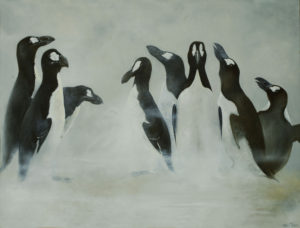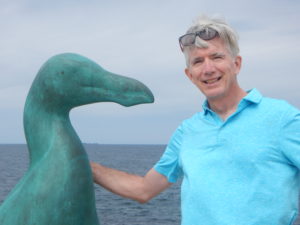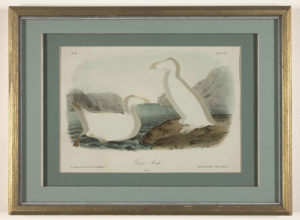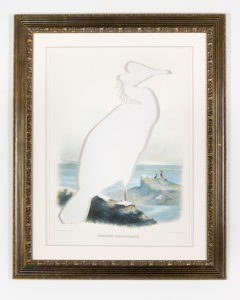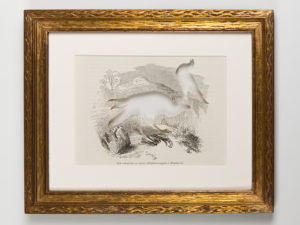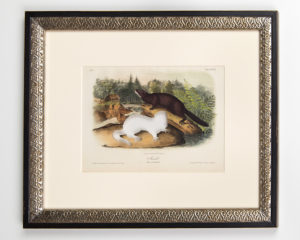What good is sitting alone in your room?
Come hear the music play
Life is a cabaret, old chum
Come to the cabaret
So sings Liza Manelli’s character in the film version of the 1966 Broadway hit, Cabaret, an homage to Weimar Berlin where the artform flourished before being shut down by the Nazis in the early 1930’s. From its origins at Le Chat Noir in Paris in 1881, the cabaret was entertaining musical theater, with singing and dancing as regular fare, together with an intellectual punch provided by social and political satire. Given its varied nature, the cabaret is the perfect artform for taking on challenging topics like the biodiversity crisis.
On a recent Friday I had a chance to see, Mirabilis: Stories of Wonder and Loss – An Extinction Cabaret, a new theater piece co-directed by Kyna Hamill and Wanda Strukus of Two Roads based on my book, Brief Eulogies for Lost Animals: An Extinction Reader. Though described as a work in progress, the segments that were performed were highly polished and engaging.

My motivations for writing the book were to restore some of these lost animals to our cultural memory. Animals are among our first memories, not just for our stuffed toys, but for our own culture. Our ancestors didn’t paint mountains and trees in the caves of Europe, they painted animals. Both wild and tame, they are our companions here on Earth.
To our folly, we’ve not recognized animals as companions and we’ve lost so many species: through carelessness (the introduction of invasive species), through shortsightedness (habitat loss) and through ignorance (over-exploitation – “Surely, this can’t be the last of them?”). But the animals had a right to their place on the tree of life just like we do.
Mirabilis takes on all of this and is jammed full of highlights – the stories of the lost animals sing out. I was struck by the innocence of the Falklands Islands wolf. Two Roads depicts it as exuberant and playful – and rather adorable – and yet it wound up being hunted to extinction for its pelt. The plight of the Mascarene tortoises hits home too when we see them as voyagers who cast themselves into the sea not knowing where they would wind up. Able to live for more than two hundred years, they are described as the “wise old masters of the Earth.” Incredibly, when they gathered on Mauritius, they were in herds that numbered in the thousands. In another piece, the actors read out individual characteristics of a handful of lost species so that we glimpse them all too briefly before they are gone.
Like any good cabaret, Mirabilis has strong satirical elements and we humans get knocked for our obsession with selfies (in this case, the actors jostle over who can get their selfie taken with the last living bee) and one of the most upbeat songs, called We Ate Them All, is a gleeful lampooning of humans for eating the dodo, passenger pigeon, Labrador Duck and Steller’s Sea Cow to extinction. Other pieces rightfully poke fun at us for being too scared to take action and for getting used to bad environmental news, as if it’s all going to get better on its own.
There are many ways to grieve. When we lose a loved family member or friend, we gather and celebrate them, we wonder at their lives and how they’ve touched us. The segments of wonder in Mirabilis each stand out. In one piece, two actresses are speaking to different parts of the audience and for the one facing me, she was talking about being on the beach in California and wondering if someone was in Japan, also with her feet in the ocean, wondering about connecting with someone an ocean away.
Another piece, called “The Whales,” sees the entire troupe floating about on the stage, coming up occasionally for air, as a recording of the song of the humpback whales plays in the background. It’s a quiet piece, with slow, meditative movements made all the more powerful by the whalesong in the background. In fact, the recording is from the original 1970’s record that was included in a special issue of National Geographic, with narration by Dr. Roger Payne. It was Dr. Payne’s work on whalesong that helped bring about the “Save the Whales” movement that is one of the 20th century’s great environmental success stories. As Dr. Payne reminds us on the recording, whalesong is featured on the Voyager spacecraft’s Golden Record, now jetting its way out of the solar system, bringing their wondrous sounds to the rest of the galaxy. To me, the songs and the movement were a reminder that something very special is happening here on Earth. I wanted to linger in that feeling.
To wonder at nature and at the world is to love it. Mirabilis is a cabaret of wonders and I look forward to the next iteration of this entertaining and provocative work in progress.

